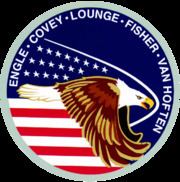COSPAR ID 1985-076A Orbits completed 112 Apogee 465,000 m Launch date 27 August 1985 | SATCAT no. 15992 Period 1.5 hours Dates 27 Aug 1985 – 3 Sep 1985 Landing date 3 September 1985 | |
 | ||
Mission type Satellite deploymentSatellite repair Mission duration 7 days, 2 hours, 17 minutes, 42 seconds Distance travelled 4,698,602 kilometres (2,919,576 mi) Members Joe Engle, Richard O. Covey, James van Hoften, John M. Lounge, William Frederick Fisher | ||
STS-51-I was the 20th mission of NASA's Space Shuttle program and the sixth flight of Space Shuttle Discovery. During the mission, Discovery deployed three communications satellites into orbit. The mission launched from Kennedy Space Center, Florida, on August 27, 1985, and landed at Edwards Air Force Base, California, on September 3.
Contents
Cnn coverage of the sts 51 i launch
Spacewalks
Mission summary
Discovery launched at 6:58 am EDT on August 27, 1985. Two earlier launch attempts, one on August 24 and another on August 25, were scrubbed – the first because of poor weather, and the second because the backup orbiter computer failed and had to be replaced. The successful launch on August 27 took place just as an approaching storm front reached the launch pad area.
The five-man STS 51-I crew included Joe H. Engle, commander; Richard O. Covey, pilot; and James van Hoften, John M. Lounge, and William F. Fisher, mission specialists. Their primary mission was to deploy three commercial communications satellites and retrieve and repair the Syncom IV-3 satellite, which had been deployed during the STS 51-D mission in April 1985, but had malfunctioned. In addition, a mid-deck materials processing experiment, the Physical Vapor Transport Organic Solid Experiment (PVTOS), was flown aboard Discovery.
The three communications satellites were Aussat 1, a multi-purpose spacecraft owned by Australia; ASC-1, owned and operated by the American Satellite Company; and Syncom IV-4, leased to the Department of Defense by its builder, Hughes Co. Both Aussat 1 and ASC-1 were deployed on the day of the launch, 27 August. Syncom IV-4 was deployed two days later. All three achieved their planned geosynchronous orbits and became operational.
On the fifth day of the mission, astronauts Fisher and van Hoften began repair efforts on the malfunctioning Syncom IV-3, following a successful rendezvous maneuver by Discovery. The effort was slowed by a problem in the Remote Manipulator System elbow joint. After a second EVA by Fisher and van Hoften, the satellite's control lever was repaired, permitting commands from the ground to activate the spacecraft's systems and eventually send it into its proper geosynchronous orbit. The two EVAs lasted a total of 11 hours and 46 minutes.
Discovery landed on Runway 23 at Edwards Air Force Base at 6:16 am PDT on September 3, 1985. The flight lasted a total of 7 days, 2 hours, 18 minutes and 42 seconds, during which the shuttle completed 111 orbits of the Earth.
Wake-up calls
NASA began a tradition of playing music to astronauts during the Gemini program, and first used music to wake up a flight crew during Apollo 15. Each track is specially chosen, often by the astronauts' families, and usually has a special meaning to an individual member of the crew, or is applicable to their daily activities.
